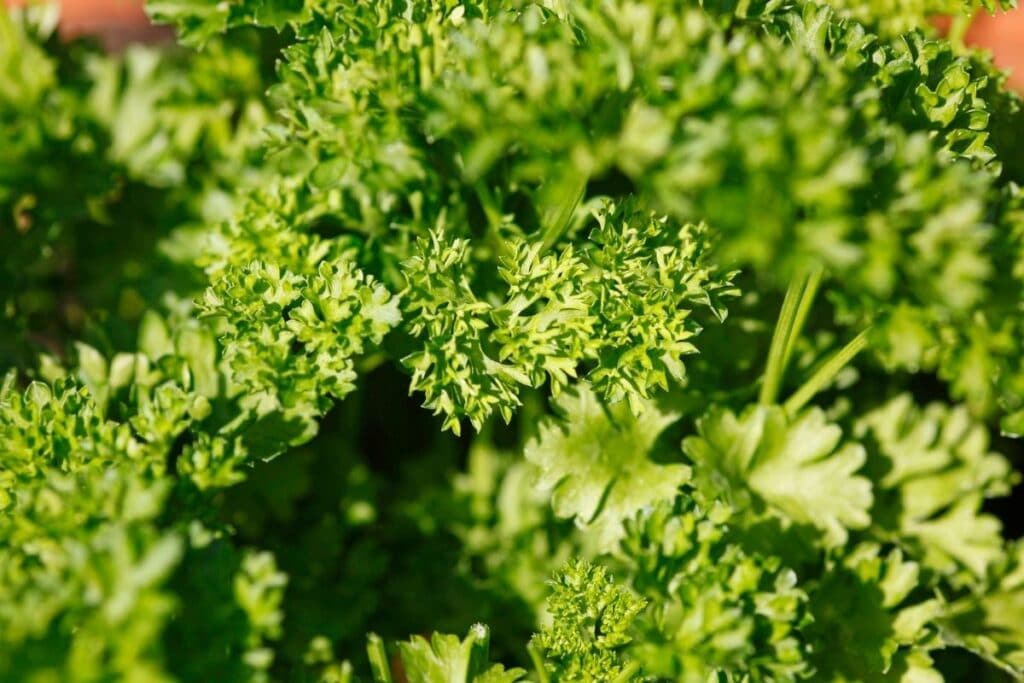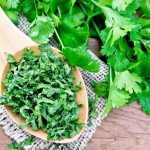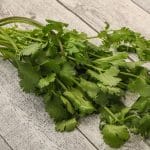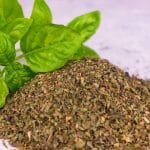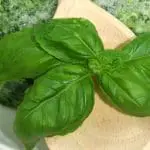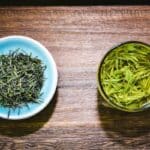In summary: Alternatives to parsley include tarragon, cilantro leaves, basil, chervil, etc. Each alternative has a unique taste and texture; pick the one that best complements your recipe and personal preferences.
Parsley is such a versatile aromatic herb. It can be used for cooking, as a salad green, garnishing, in coatings, garlic bread, fresh, and dried. You are probably familiar with one of the two most common types of parsley, namely curly or flat-leaf.
Bright green curly parsley leaves are mainly used as whole or chopped fresh parsley to garnish salads, rice, vegetables, fish, and meaty dishes. Flat-leaf parsley (also sometimes referred to as Italian parsley) is a key ingredient in falafels and is used as a garnish and flavoring in stocks, stews, casseroles, sauces, and soups. Parsley also serves as one of the main ingredients in condiments such as gremolata and pesto.
If your herb garden supply is not ready, you’ve run out, or you can’t find any in-store, we’ve listed some of the best substitutes for parsley you can use instead to give your cooking the same vibrant touch and herbaceous flavor.
Fresh or Dried Parsley?
When you use parsley as a garnish, fresh leaves should be your go-to. Dried parsley refers to the freeze-dried crumbled leaves with a much finer texture. You can also dry your own herbs at home to extend the shelf-life significantly. The dried version is best used in savory baked items, dressings, stews, casseroles, and other cooked dishes.
It is always best to replace fresh herbs for fresh and to use dried herbs as a replacement when your recipe calls for the dried version. As a second option, if you are in a pinch, you can substitute dry parsley for fresh and vice versa (if the application is appropriate). In general (although there are a few exceptions), dried herbs are stronger in flavor than fresh herbs, so you can use less when replacing dried for fresh herbs. A good guideline is to use 1 teaspoon of dried herbs to replace one tablespoon of fresh herbs.
Best Parsley Substitutes
1. Chervil
Chervil is an excellent fresh alternative to parsley since it’s part of the same herb family. Chervil leaves have a similar appearance to flat-leaf parsley, milder flavor, and is commonly used in French cuisine.
The stronger flavor of parsley can sometimes be a little overwhelming, and in these cases, chervil is an excellent substitute. However, if that pronounced taste is what you are after, make sure you add a little more chervil to your cooking to achieve the same potency.
How to use it: Add it chopped to omelets, scrambled eggs, salads, potatoes, and as part of a stuffing for chicken or fish. Also suitable for salad dressings, dips, soups, and sauces.
2. Tarragon
Another popular herb in French cooking is tarragon. It has oblong, tender leaves and a licorice-like flavor. Although somewhat different in taste, fresh or dried tarragon can be a good replacement in small amounts as it complements a variety of dishes.
How to use it: Add it to fish, chicken, or egg dishes as a garnish whole or chopped. Mix it into salad dressing, oils for roasting veg, sauces, pesto, aioli, and combine with other salad greens.
See more: Substitute for tarragon
3. Oregano
Oregano is a herb popularly used dried as well as fresh in pizza and pasta sauces. It has strong savory notes that add a remarkable complexity to recipes. It has an intense flavor, so add a smaller amount than when used as a substitute and adjust to taste. Dried oregano is a convenient replacement for parsley, especially in stews and vinaigrette.
How to use it: Popular in Italian dishes, oregano works well in tomato-centric dishes and sauces. It is often combined with olive oil for meat, chicken, vegetable marinades, and salad vinaigrette.
4. Chives
If you are looking for the same pop of color to garnish your dish, fresh chives are a great option. They have a similar flavor to onions and garlic and look like slender long green onion sprigs. Although they don’t taste or look the same as parsley, they’re still a fantastic way to finish a dish just to give it a little extra pizzazz.
How to use it: Chop chives finely and add to scrambled eggs and omelets, potato dishes, fish, soups, and dips. Also, sprinkle lightly over mini quiches and canapes for a finishing touch. When adding chives to cooked dishes, always add them at the end as heat will dull the flavor.
5. Arugula
Also referred to as rocket, this leafy green has a mild peppery taste and is slight bitter. The leaves are somewhat bigger, so chop arugula finely when using it as a substitute for parsley.
How to use it: Mix arugula into salads or use it to make pesto. It combines well with potato salads, meatballs, and even pizza.
6. Curly Endive
Even though curly endive has a more pronounced bitter and peppery flavor, it makes a great alternative green due to its appearance. Curly leaf endive and curly leaf parsley have a very similar look. Use a slightly smaller amount of curly endive to ensure the strong flavor doesn’t overpower your dish.
How to use it: Curly endive can be used in cooked dishes or as a garnish. Add it into salads, chopped and sautéed, and to vegetable or bean soup. Finely chopped, it can also be sprinkled as a garnish over eggs, meat dishes, casseroles, and stews.
Note: Curly endive and Belgian endive are not the same product, so make sure to pick the correct version when choosing to replace parsley. The Belgian endive looks like a cylindrical head of lettuce with a pale yellow-green color. Curly endive is sometimes referred to as frisee and has curly frilly green leaves.
7. Cilantro Leaves
Fresh cilantro, also sometimes referred to as coriander, has a very pronounced flavor that can easily overpower a dish if you are not used to cooking with it. It is commonly used in Indian, Mexican, or Thai dishes and although the flavor is different, the appearance of cilantro and flat-leaf parsley are comparable.
How to use it: Cilantro is best used as a garnish when replacing parsley due to its strong flavor. Make sure it matches the other flavors in your dish before adding it too liberally. If you are familiar with the taste, fresh or dried cilantro can be added to curries, stews, soups, and noodle dishes.
See more: Coriander substitute
8. Basil
Fresh basil leaves are much bigger than parsley and have a bold flavor with hints of licorice. Largely used in Italian cuisine, basil is best used to substitute parsley when making Italian recipes to ensure flavor compatibility. When using it in a cooked dish, use dried basil as this is slightly subdued. Alternatively, start with a smaller amount and adjust to taste.
How to use it: Basil often forms the main ingredient in pesto together with pine nuts and olive oil. It can be used successfully as part of a green salad mix, pasta, pizza, dips, dressings, egg, and chicken dishes.
9. Celery Leaves
Celery leaves are a good substitute for flat-leaf parsley in terms of appearance. They are a little bitter with a very subtle flavor so that they won’t impact the taste of your dish too much.
How to use it: Celery leaves are best used as a garnish and in stock.
10. Carrot Greens
Carrot greens are best used as a garnish. Their bitter taste makes them unsuitable to replace as a cooking ingredient in most cases unless used in very small quantities. So if you are already using carrots in your dish and don’t have parsley on hand, finely snip off the greens, clean them and use them to brighten up your dish.
11. Fines Herbes
This is a French herb blend made of parsley, chives, chervil, and tarragon. You can use this fresh if you can’t find parsley on its own or use the dried version in cooking and sauces.
How to use it: Use the fresh herb blend as a garnish. Use dried or fresh fine herbs for chicken, fish, vegetable, and egg dishes.
FAQs
Conclusion
Parsley is so versatile for all types of savory dishes, from sauces and soups to condiments, casseroles, meat, baked goods, and stuffing. Its bright color jazzes up any plate that needs an artful touch.
When you’re all out, use celery leaves, cilantro, or carrot greens as a garnish and opt for chervil or chives in cooked dishes. Whichever you choose, always add fresh herbs at the end of the cooking time or just before serving as they lose some flavor when exposed to heat.
See more: how to dry parsley
*image by imagebrokermicrostock/depositphotos
